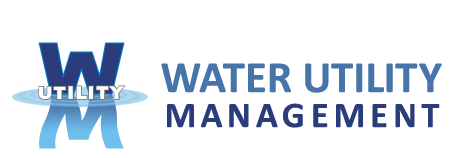Water Meter Education
A water meter is measures the quantity (volume) of water that passes through a pipe or other outlet. Typically, meters use a standard unit of measure for volume, such as cubic feet or gallons. Your meter works like a car odometer, recording the cumulative amount of water that has passed through the meter. WUM records every reading, and subtracts the old reading from the new reading to determine the amount of water used since the previous read. By understanding how to read your meter and calculate your usage, you will be able to verify that we are reading your meter fairly and accurately, and to spot problems, such as leaks.
Why Read Your Meter?
Helpful Tip:
Read your meter periodically and record the results! This helps with water conservation practices and in identifying water leaks ahead of time.
Bill Higher Than Normal?
Download our Leak Check document for more information on checking for household leaks. For account inquiries or additional assistance with an unexpected high water bill, please contact our office.
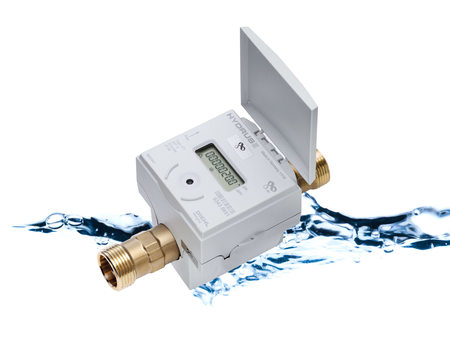
Updated Meters
For customers with updated meters installed at their residence, simply open the lid of your meter to expose the sensor to sunlight for an automatic scrolling of meter information. Our new meter hardware is comprised of a static water meter based on ultrasonic technology. This update in technology provides WUM customers with an extremely accurate usage calculation of water consumption and further eliminates measuring deviations caused by sand, suspended particles, or air pockets. Concerned about an unusual bill spike? Please visit our High Water Bill page for tips, education, and how to handle an unusual bill.

Updated Meters
For customers with updated meters installed at their residence, simply open the lid of your meter to expose the sensor to sunlight for an automatic scrolling of meter information. Our new meter hardware is comprised of a static water meter based on ultrasonic technology. This update in technology provides WUM customers with an extremely accurate usage calculation of water consumption and further eliminates measuring deviations caused by sand, suspended particles, or air pockets. Concerned about an unusual bill spike? Please visit our High Water Bill page for tips, education, and how to handle an unusual bill.
Step 1: Locate your meter box.
To read your water meter, you’ll need to locate it first. Most meters are located in your front lawn or near the curb or sidewalk, though some can be in a side yard, or even your back yard. The meter “box” will include a metal or plastic lid that reads “Water” or “Water Meter.” To remove the lid, use a long metal screwdriver, and pry gently from the side of the box. Wearing gloves is an additional option for added protection from hot lids or from boxes that have become natural homes for wildlife, including insects, frogs, and even snakes.
Step 2: Identify your type of water meter.
Though we are currently in the process of replacing outdated meter hardware, some customers may still have previous models of Digital or Analog meters at their residence. Please see below for examples of both types:
Digital Meter
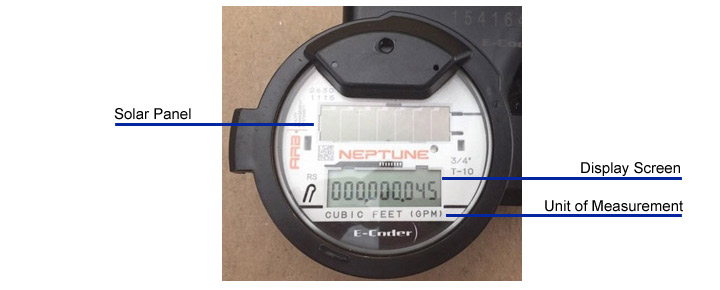
Anatomy of a Digital Meter:
Display – The digital meter needs light for activation so you may need to shine a flashlight on it. The display alternates between the meter read and the flow rate. The meter read equals the gallons (or cubic feet) used while the flow rate equals the number of gallons (or cubic feet) per minute flowing through the water meter.
Analog Meter
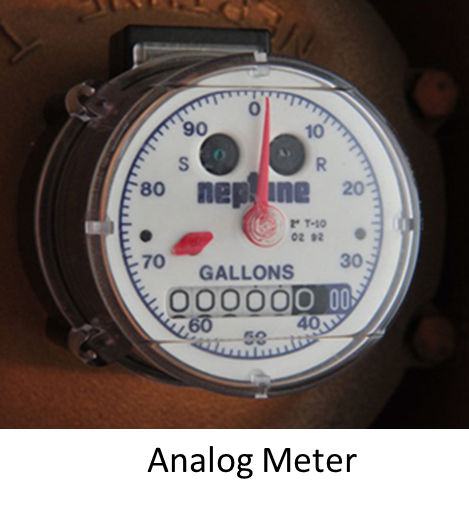 The large, red sweep hand on an analog meter is used to measure water in gallons or cubic feet. When the large sweep hand moves from one number to the next (e.g. 0 to 1), then 1 gallon or 1 cubic foot of water has passed through your water meter.
The large, red sweep hand on an analog meter is used to measure water in gallons or cubic feet. When the large sweep hand moves from one number to the next (e.g. 0 to 1), then 1 gallon or 1 cubic foot of water has passed through your water meter.
Identifying your Unit of Measurement
Unit of Measure – WUM provides meters that measure in cubic feet and meters that measure in gallons. 100 cubic feet of water is equal to 748 gallons of water.
Does your meter measure in Gallons?
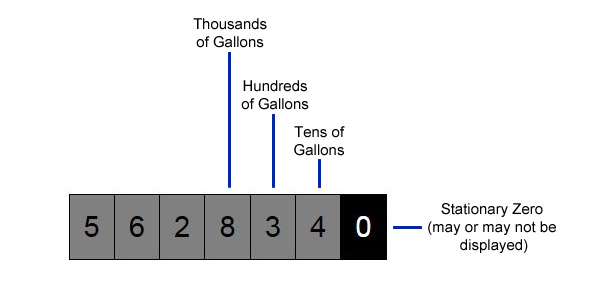
Example: 5,628,340 gallons have been used in total since the installation date.
Does your meter measure in Cubic Feet?
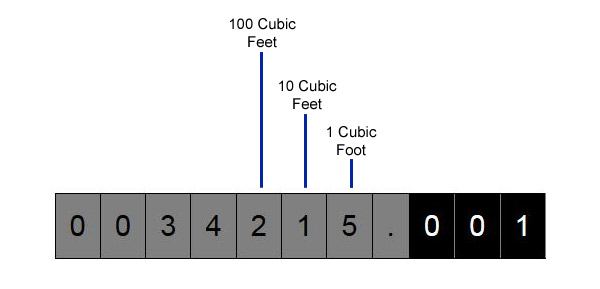
Example: 34,215 cubic feet of water was used since the date of installation. To convert cubic feet to gallons, multiply the number of cubic feet by 7.48. (34,215 ft3 * 7.48 = 255,928.2 gallons) Now we know that 255,928.2 gallons have been used since the date of installation.
Performing a Leak Test
- Turn off all indoor and outdoor water appliances. Don’t forget icemakers and irrigation spigots. Do not turn on any water during this test.
- There will be two different numbers that display on your meter. They are the meter read and flow rate. The meter read is the total amount of water used since the installation date. It will always be the larger number. The other number that will flash on the screen is the flow rate. This is how much water is flowing currently.
- After turning off your water, record the meter read on your odometer. This will be your 1st Reading. (When all water is off, if the flow rate is not 0, then you have a small leak.)
- Wait 20 minutes. This is the minimum amount of time needed to give you a clear read.
- After the 20 minutes have passed, go back to your water meter and take another reading of the numbers on your “odometer.” This is your 2nd Reading.
- Do the math.

If X equals 0, and your low flow indicator is not moving, then you do not have a leak. If x is any number greater than 0, but all water utilities are turned off, then you have a leak.
Special Note about Water Leaks
Some leaks may only appear at higher pressures and “disappear” during lower pressures. If you suspect a leak, keep monitoring over a long period of time. Record your water use intermittently and keep a log of your usage. A classic example of a leak that may not appear immediately is a sprinkler head that does not always set. Please visit our High Water Bill page for more information on types of water leaks or what to do after receiving a high water bill. Visit our Leak Adjustment page for more information and current eligibility requirements.
